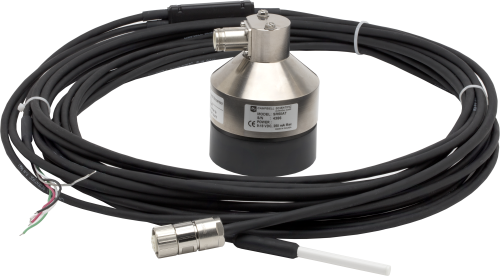This product has limited availability. Some accessories, replacement parts, or services may still be available when it is no longer available.







Overview
Note: This product has limited availability. Please consider the SnowVue™10 Digital Snow-Depth Sensor for snow-depth measurements and the TempVue™20 Pt100 Digital Air Temperature Sensor or HygroVue™10 Digital Temperature and Relative Humidity Sensor with M12 Connector for air temperature measurements.
The SR50AT-L is an acoustic distance sensor that measures the elapsed time between emission and return of an ultrasonic pulse. This measurement can be used to determine snow depth. The SR50AT-L includes an external temperature sensor and outputs a temperature-corrected distance reading, eliminating the need for further post-processing.
Read MoreBenefits and Features
- Integrated temperature probe for providing temperature correction of measurements
- Non-contact method for determining snow depth
- Wide operating temperature range
- Rugged enough for harsh environments
- User-selectable options for output
- Uses a multiple echo processing algorithm to help ensure measurement reliability
- Compatible with most Campbell Scientific data loggers
Images






Detailed Description
The SR50AT is an identical unit to the SR50A with the addition of an external temperature sensor. The temperature sensor requires a six-plate radiation shield. The SR50AT will output a temperature-corrected distance reading, eliminating the need for further post-processing, as well as a separate temperature reading.
The SR50AT was designed to meet the stringent requirements of measuring snow depths and uses a multiple echo processing algorithm to help ensure measurement reliability. The SR50AT is compatible with all current Campbell Scientific data loggers, as well as many other data acquisition systems. An air temperature measurement is required to correct for variations of the speed of sound in air. Either the SR50AT or an existing on-site air temperature sensor can be used. The SR50AT is available with a heater option for locations where rime ice is a problem.
Specifications
| Measurement Time | < 1.0 s |
| Output Options | SDI-12 version 1.3, RS-232, RS-485 (output options selected by configuring internal jumpers) |
| Baud Rates | 1200 to 38400 bps (RS-232, RS-485 modes) |
| Power Requirements | 9 to 18 Vdc (typically powered by data logger’s 12 Vdc power supply) |
| Measurement Range | 0.5 to 10 m (1.6 to 32.8 ft) |
| Beam Acceptance Angle | ~30° |
| Resolution | 0.25 mm (0.01 in.) |
| Accuracy | ±1 cm (0.4 in.) or 0.4% of distance to target (whichever is greatest). |
| Operating Temperature Range | -45° to +50°C |
| Compliance | CE compliant |
| Temperature Accuracy |
|
| Cable Type | 4 conductor, 2-twisted pair, 22 AWG, Santoprene |
| Diameter | 7.6 cm (3 in.) |
| Length | 10.1 cm (4 in.) |
| Weight | 375 g (13.2 oz) without cable |
| Cable Weight | 250 g (8.2 oz) for a 4.57-m (15-ft) cable |
Power Consumption |
|
| Active | 250 mA (typical) |
| Quiescent SDI-12 Mode | < 1.0 mA The quiescent current draw is less than 1.25 mA if the BAUD rate is 9600 BAUD or less |
| RS-232/RS-485 Mode | < 2.0 mA |
Maximum Cable Length |
|
| -NOTE- | Cable lengths greater than 60 m require a heavier gage wire if the power supply drops below 11 Vdc. |
| SDI-12 | 60 m (200 ft) |
| RS-232 | 60 m (200 ft) 9600 BAUD or less |
| RS-485 | 300 m (984 ft) |
Compatibility
Note: The following shows notable compatibility information. It is not a comprehensive list of all compatible or incompatible products.
Data Loggers
| Product | Compatible | Note |
|---|---|---|
| CR1000 (retired) | SDI-12 and RS-232. For RS-485, requires an MD485 interface or similar RS-485 to RS-232 interface. | |
| CR1000X (retired) | SDI-12 and RS-232. For RS-485, requires an MD485 interface or similar RS-485 to RS-232 interface. | |
| CR300 (retired) | SDI-12 and RS-232. For RS-485, requires an MD485 interface or similar RS-485 to RS-232 interface. | |
| CR3000 (retired) | SDI-12 and RS-232. For RS-485, requires an MD485 interface or similar RS-485 to RS-232 interface. | |
| CR310 | SDI-12 and RS-232. For RS-485, requires an MD485 interface or similar RS-485 to RS-232 interface. | |
| CR350 | SDI-12 and RS-232. For RS-485, requires an MD485 interface or similar RS-485 to RS-232 interface. | |
| CR6 | SDI-12, RS-232, and RS-485 | |
| CR800 (retired) | SDI-12 and RS-232. For RS-485, requires an MD485 interface or similar RS-485 to RS-232 interface. | |
| CR850 (retired) | SDI-12 and RS-232. For RS-485, requires an MD485 interface or similar RS-485 to RS-232 interface. |
Miscellaneous
| Product | Compatible | Note |
|---|---|---|
| Granite 6 (retired) | SDI-12 and RS-232. For RS-485, requires an MD485 interface or similar RS-485 to RS-232 interface. |
Additional Compatibility Information
Data Logger Considerations
One single-ended channel per probe is required; an excitation channel can be shared by several probes.
Downloads
Articles and Press Releases
Newsletter Articles
Privacy Policy Update
We've updated our privacy policy. Learn More
Cookie Consent
Update your cookie preferences. Update Cookie Preferences

